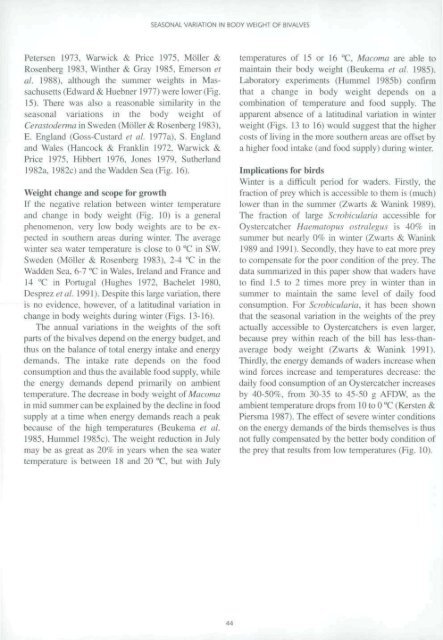waders and their estuarine food supplies - Vlaams Instituut voor de ...
waders and their estuarine food supplies - Vlaams Instituut voor de ...
waders and their estuarine food supplies - Vlaams Instituut voor de ...
Create successful ePaper yourself
Turn your PDF publications into a flip-book with our unique Google optimized e-Paper software.
Petersen 1973. Warwick & Price 1975. Moller &<br />
Rosenberg 1983. Winther & Gray 1985. Emerson et<br />
al. 1988). although the summer weights in Massachuscits<br />
(Edward & Huebner 1977) were lower (Fig.<br />
15). There was also a reasonable similarity in the<br />
seasonal variations in the body weight of<br />
Cerasto<strong>de</strong>rma in Swe<strong>de</strong>n (Moller & Rosenberg 1983).<br />
E. Engl<strong>and</strong> (Goss-Custard et al. 1977a). S. Engl<strong>and</strong><br />
<strong>and</strong> Wales (Hancock & Franklin 1972. Warwick &<br />
Price 1975. Hibberi 1976. Jones 1979. Sutherl<strong>and</strong><br />
1982a. 1982c) <strong>and</strong> the Wad<strong>de</strong>n Sea (Fig. 16).<br />
Weight change <strong>and</strong> scope for growth<br />
II" Ihe negative relation between winter temperature<br />
<strong>and</strong> change in body weight (Fig. 10) is a general<br />
phenomenon, very low body weights are to be expected<br />
in southern areas during winter. The average<br />
winter sea water temperature is close to 0 °C in SW.<br />
Swe<strong>de</strong>n (Moller & Rosenberg 1983), 2-4 °C in the<br />
Wad<strong>de</strong>n Sea, 6-7 °C in Wales. Irel<strong>and</strong> <strong>and</strong> France <strong>and</strong><br />
14 °C in Portugal (Hughes 1972. Bachelet 1980.<br />
Desprez el al. 1991). Despite this large variation, there<br />
is no evi<strong>de</strong>nce, however, of a latitudinal variation in<br />
change in body weights during winter (Figs. 13-16).<br />
The annual variations in the weights of the soft<br />
parts of the bivalves <strong>de</strong>pend on the energy budget, <strong>and</strong><br />
thus on the balance of total energy intake <strong>and</strong> energy<br />
<strong>de</strong>m<strong>and</strong>s. The intake rate <strong>de</strong>pends on the <strong>food</strong><br />
consumption <strong>and</strong> thus the available <strong>food</strong> supply, while<br />
the energy <strong>de</strong>m<strong>and</strong>s <strong>de</strong>pend primarily on ambient<br />
temperature. The <strong>de</strong>crease in body weight oi Macoma<br />
in mid summer can be explained by the <strong>de</strong>cline in <strong>food</strong><br />
supply at a time when energy <strong>de</strong>m<strong>and</strong>s reach a peak<br />
because of the high temperatures (Beukema et al.<br />
1985. Hummel 1985c). The weight reduction in July<br />
may be as great as 20'i in years when the sea water<br />
temperature is between 18 <strong>and</strong> 20 °C. but with July<br />
SEASONAL VARIATION IN BODY WEIGHT OF BIVALVES<br />
44<br />
temperatures of 15 or 16 °C. Macoma are able to<br />
maintain iheir body weight I Beukema et al. 1985).<br />
Laboratory experiments (Hummel 1985b) confirm<br />
that a change in body weight <strong>de</strong>pends on a<br />
combination of temperature <strong>and</strong> <strong>food</strong> supply. The<br />
apparent absence of a latitudinal variation in winter<br />
weight (Figs. 13 to 16) would suggest that the higher<br />
eosis of living in the more southern areas are offset by<br />
a higher fcxxl intake (<strong>and</strong> <strong>food</strong> supply) during winter.<br />
Implications for birds<br />
Winter is a difficult period for <strong>wa<strong>de</strong>rs</strong>. Firstly, the<br />
fraction of prey which is accessible to them is (much)<br />
lower than in the summer (Zwarts & Wanink 1989).<br />
The fraction of large Scrobicularia accessible for<br />
(iv stercatcbei Haematopus ostralegus is 40% in<br />
summer but nearly i)% in winter (Zwarts & Wanink<br />
1989 <strong>and</strong> 1991). Secondly, they have to eat more prey<br />
io compensate for the poor condition of the prey. The<br />
data summarized in this paper show dial <strong>wa<strong>de</strong>rs</strong> have<br />
to find 1.5 to 2 times more prey in winter than in<br />
summer to maintain the same level of daily <strong>food</strong><br />
consumption. For Scrobicularia. it has been shown<br />
that the seasonal variation in the weights of the prey<br />
actual I \ accessible to Oystercatchers is even larger,<br />
because prey within reach of the bill has less-thanaverage<br />
body weight (Zwarts & Wanink 1991).<br />
Thirdly, the energy <strong>de</strong>m<strong>and</strong>s of <strong>wa<strong>de</strong>rs</strong> increase when<br />
wind forces increase <strong>and</strong> temperatures <strong>de</strong>crease: the<br />
daily <strong>food</strong> consumption of an Oystercatcher increases<br />
by 40-50%, from 30-35 to 45-50 g AFDW, as the<br />
ambient temperature drops from 10 to 0 °C (Kersten &<br />
Piersma 1987). The effect of severe winter conditions<br />
on the energy <strong>de</strong>m<strong>and</strong>s of ihe birds themselves is thus<br />
not fully compensated by the better body condition of<br />
the prey that results from low temperatures (Fig. 10).

















